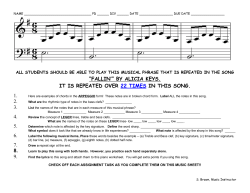
“Revisiting „Strange Fruit‟: an Exploration of Culture and Anti-Apartheid Activism”
“Revisiting „Strange Fruit‟: an Exploration of Culture and Anti-Apartheid Activism” Frankie Nicole Weaver When asked about the power of music, Pete Seeger said the following: All we know is that sometimes a short song, taking just a few minutes, can have as much impression on a listener as reading a whole novel can. A song is often a triumph of oversimplification. A novel can go into details. The song is more like a basketball backboard and you bounce the experiences of your life against it and it bounces back new meanings.1 Indeed, Seeger is correct in asserting that short songs can turn out to be incredibly powerful. Some songs open up spaces and provide potent ideas which previously were not available. And sometimes a seemingly simple song can have such strong reverberations that it is able to cross an ocean, transcend time and convince people to rethink their relations with each other and maybe even with the world. “Strange Fruit” is such a song and its echo can be heard in the anti-apartheid protest song, “Hanging on a Tree.” Central to both songs are explicit lyrics which confront listeners with the subjects, racism and lynching. While researching international anti-apartheid activism, I found a little known song entitled, “Hanging on a Tree.”2 In 1963 Vanessa Redgrave, supporting both the British AntiApartheid Movement and the British Labour Party, wrote “Hanging on a Tree” and sang it at an anti-apartheid rally in Trafalgar Square (which was and is a popular site for political demonstrations in London). According to her autobiography, Redgrave wrote “Hanging on a 1 “Extended interview section: Pete Seeger,” Strange Fruit, DVD, written and directed by Joel Katz, California Newsreel, 57 minutes, 2002. 2 Enuga S. Reddy has provided me with a wealth of information regarding international activity against apartheid and he should be credited with introducing me to the song “Hanging on a Tree.” He provided me with a copied cassette recording of Vanessa Redgrave singing “Hanging on a Tree.” In 1949 E.S. Reddy began working for the United Nations Secretariat; from 1963 to 1984 he headed action against apartheid within the organization. A copy of the song “Hanging on a Tree” can also be found in E.S. Reddy‟s collection at the University of Witwatersrand in Johannesburg, South Africa. E.S. Reddy also helped with proper song lyric transcription. Tree” because she was aware that Nelson Mandela and other members of the African National Congress (ANC) were on trial facing the death penalty and because she supported an international economic boycott aimed at protesting and isolating the South African apartheid government.3 Mandela‟s colleagues were arrested on July 11th, 1963, by the South African Police on the farm at Rivonia, near Johannesburg.4 At the time of the raid Mandela himself was already in jail serving a sentence of five years. He was then brought from jail to the new trial. Newspapers around the world depicted the “Rivonia Trial” as the most significant political trial in the history of South Africa.5 Nelson Mandela, Walter Sisulu, Govan Mbeki and others, prominent leaders of the ANC and members of Umkhonto we Sizwe (the Spear of the Nation), were formerly charged on October 11, 1963, with sabotage, conspiracy and preparation for guerilla war. The eleven month long Rivonia Trial gained unprecedented attention both within South Africa and internationally. In his autobiography, Mandela recounts a courtroom atmosphere filled with domestic and international journalists, and dozens of representatives of foreign governments.6 Mandela and his peers used the trial as a platform to reach out to a broad audience. Mandela writes, Right from the start we had made it clear that we intended to use the trial not as a test of the law but as a platform for our beliefs. We would not deny, for example, that we had been responsible for acts of sabotage. We would not deny that a group of us had turned 3 Vanessa Redgrave, Vanessa Redgrave: An Autobiography, (NY: Random House, 1991): 132-133. Redgrave is famous both as a cultural personality and actor, as well as, political activist. She was born in Blackheath, London in 1937. During the 1960s, Redgrave became a political activist. She joined the Campaign for Nuclear Disarmament, Bertrand Russells‟s Committee of 100 and actively supported the independence of Vietnam, the rights of Palestinians, Nelson Mandela and the ANC, the Irish liberation struggle and has worked as UNICEF‟s Special Representative for the Performing Arts in what was formerly Yugoslavia and within Sarajevo. Today, at age 71, she remains active both in theatre and cinema, as well as, politics (Redgrave, 3 and 423). 4 “Rivonia Trial: 1963-1964,” from official website of the African National Congress, http://www.anc.org.za/ancdocs/history/trials/index.html#Rivonia, viewed on 19 March 2008, last updated July 8, 2006. 5 Nelson Mandela, Long Walk to Freedom: the Autobiography of Nelson Mandela, (Boston, etc: Little, Brown and Company, 1994): 351. 6 Mandela, 351. 2 away from nonviolence. We were not concerned with getting off or lessening our punishment, but with having the trial strengthen the cause for which we were all struggling – at whatever cost to ourselves.7 Those accused chose to fight a moral battle in court even though they knew that they faced the “supreme penalty – death by hanging.”8 The threat of death by hanging was very real; the South African regime hung 120 people in 1963 and 89 in 1964.9 According to Gail Gerhart and Thomas Karis, “Anti-apartheid groups succeeded in focusing unprecedented international attention on the trial and in generating pressures to end it or at least to save the defendants from the death penalty.”10 Internal as well as international protest certainly helped to prevent the court from sentencing the men to the death. On June 12th, 1964, Mandela, Sisulu, Mbeki and others were sentenced to life imprisonment. Like other anti-apartheid organizations, the Anti-Apartheid Movement (which is the name of British activist movement against apartheid) worked to ensure that the trial obtained the broadest possible publicity. The organization held vigils, they lobbied Parliament, marched in protest, and presented petitions to the South African Embassy.11 In November of 1963 the Anti-Apartheid Movement conducted a month long campaign which emphasized such issues as: the release of political prisoners, curtailing the British supply of arms to South Africa, complete asylum and protection for South African refugees, and economic sanctions. The organization opened their “Anti-Apartheid Month” with the “March against Apartheid” in which Redgrave, as well as at least 100 other well-known figures, 7 Ibid., 360. Ibid., 353. 9 Anti-Apartheid Movement UK “Annual Report,” (Oct. 1965): 3, from Anti-Apartheid Archives, accessed through ALUKA at http://www.aluka.org/ . 10 Gail M. Gerhart and Thomas Karis, “Toward Robben Island. The Rivonia Trial,” From Protest to Challenge, Vol. 3, (1977), http://www.anc.org.za/ancdocs/history/trials/toward_robben_island.html, viewed on 19 March 2008, last updated July 8, 2006. 11 Anti-Apartheid Movement UK “Annual Report,” (Oct. 1964): 4, from Anti-Apartheid Archives, accessed through ALUKA at http://www.aluka.org/ . 8 3 marched. According to the Anti-Apartheid Movement Annual Report, demonstrators passed in front of the South African Embassy, stopping to place an African-shaped wreath at the main gate, before continuing to Trafalgar Square. Upon arrival Mr. Humphrey Berkeley, Woodrow Wyatt, Rev. Nicholas Stacey, Vanessa Redgrave and Robert Resha each addressed the crowd. 12 Rather than address the crowd more traditionally by presenting a speech, Redgrave chose to sing. Her song revealed that British trade, and thus British consumers, directly supported the exploitation of South African blacks by financing and providing legitimacy for the apartheid regime. Furthermore, “Hanging on a Tree” posits that the apartheid government was no more than an unwarranted mob, whose sanctioned hangings were equivalent to legalized lynchings. Thus, Redgrave‟s song challenged listeners to question the legitimacy of the apartheid government and to rethink their international economic relations. Following the Trafalgar Square rally the lyrics of “Hanging on a Tree” were published in The Observer.13 The song was also recorded together with a reading of Paul Éluard‟s poem “Liberté, j‟écris ton nom.” (Which translates as: “Liberty, I write your name.”)14 Following the publication of the words, Sir Jock Campbell attempted to publish the lyrics in a form of an advertisement in The Financial Times. Campbell wrote to Redgrave, “…having been deeply moved and impressed by the words of your song published in The Observer, I decided to try to 12 Anti-Apartheid Movement UK “Annual Report,” (Oct. 1964): 3-4. Redgrave, 133. 14 Eugène Grindel (14 Dec. 1895 – 18 Nov. 1952), writing under the pen name of Paul Éluard, wrote revolutionary poetry. He is remembered as one of the founders of the Surrealist movement and for his involvement with the French Communist Party. Grindel fought Fascism both militarily and figuratively through his art during World War II; much of his poetry, simple, yet militant, evokes notions of freedom. His poems were circulated to increase morale among the French public during WWII. In the last stanza of “Liberty, I write your name” Grindel wrote, By the power of the word I regain my life I was born to know you And to name you Liberty. Paul Éluard, “Liberté, j‟écris ton nom,” http://www.wikilivres.info/wiki/index.php/Liberty, Viewed on 3 March 2008. Autobiographical notes on Éluard can be found online at: http://www.poets.org/poet.php/prmPID/766. 13 4 get them published, in the form of an advertisement in The Financial Times. Businessmen being usually more romantic it occurred to me that they might be influenced by your poem in a way which they are not by factual reporting from South Africa. Hence my choice of The Financial Times.”15 Campbell was moved by Redgrave‟s song and thus believed that it could possibly persuade his peers to reconsider their economic relations with South Africa. Campbell‟s description of “businessmen” as “more romantic” and thus more likely to respond favorably to Redgrave‟s lyrical plea for boycott seems naïve, especially since the advertisement was too controversial to even make it to print; still, Campbell offers a thought provoking notion. Campbell asserts that while “factual reporting” may not be able to convince people to act, culture or artistic expression may have a special power of persuasion. Redgrave‟s lyrics are quite persuasive. Redgrave wrote, I saw a black man hanging on a tree burnt by the sun as black as black can be What can I do to set you free? I asked and his white bones answered me called to me to me Don‟t send your ships to us across the sea Don‟t buy our food or sell your cars to me If you‟re afraid then please don‟t say, you pity me you pity me you pity me A thousand million pounds invested in my land in trade and investment that‟s a million grand Take it away, oh take it away If you won‟t then please don‟t say, you pity me you pity me you pity me 15 Ibid., 133. 5 If you make money from Verwoerd, how can you tell him that he‟s wrong? If you prefer to make your money then don‟t sing my freedom song You say that you want to make me free Then don‟t trade with the men who are killing me Or don‟t you say, you pity me And don‟t you say “it‟s a risky thing to do I‟m worried that a boycott might be bad for you” I know how to live on nothing much better than you So don‟t you say Oh, please don‟t say, you pity me So now you can choose, but oh don‟t wait too long For my brothers they will fight and their freedom wish is strong Your leaders say that they pity me, but your thousand million pounds are the seed of the tree On which they‟re hanging hanging, hanging On which they‟re hanging me Oh, my loving friends I can‟t get from my mind those white bones in the sun that whispered on the wind If there‟s no help soon then hanging from this tree will be thousands and thousands like you and like me No money making then and no ships upon the sea Just white bones in the sun hanging, hanging, hanging on a tree.16 “Hanging on a Tree” informs, pleads with, and warns its audience. The title and first line of the song, “I saw a black man hanging on a tree” immediately evoke the image of a lynching. By associating apartheid with lynching, Redgrave educates her listeners as to the exploitation and racism connected to their economic transactions. Redgrave encourages listeners to stop supporting the regime and instead to take action through economic boycott against the apartheid. She sings, “Don‟t send your ships to us across the sea, Don‟t buy our food or sell your cars to me.” Redgrave clearly articulates the significance of British investment in South Africa. Once informed, listeners can no longer support the apartheid unwittingly. Redgrave sings, “So now 16 Vanessa Redgrave, “Hanging on a Tree,” (1963). 6 you can choose.” Redgrave also cautions her listeners to make the correct decision because time is of the essence and their “thousand million pounds are the seed of the tree.” Redgrave‟s words also emphasize that listeners must avoid hypocrisy. Redgrave‟s rhetorical question, “If you make money from Verwoerd, how can you tell him that he‟s wrong?” reminds her audience that their actions should match their words. Also, the song repeats numerous times, “please don‟t say, „you pity me‟.” Redgrave insinuates that pity can turn to victimization and hypocrisy, rather than correct action. Redgrave does not want her listeners, or their governments, to simply express sorrow for the black victim whose white bones are speaking to her, she uses her words to encourage action. Redgrave‟s description of a black man “as black as black can be” with “white bones” like everyone else, reminds the audience of the man‟s humanity and promotes solidarity with the South African freedom fighters. The song ends ominously, “If there‟s no help soon then hanging from this tree will be thousands and thousands like you and like me. No money making then and no ships upon the sea. Just white bones in the sun hanging, hanging, hanging on a tree.” Redgrave‟s listeners are cautioned to change their ways and to act virtuously before it‟s too late for everyone. Redgrave produced a piece of anti-apartheid movement culture which encouraged scrutiny of racism, political action, and international connection. “Hanging on a Tree” is clearly a protest song; it is political and advances an explicit agenda. The song links racism and injustice to apartheid, and, it comes at a time when stories surrounding the Rivonia trial and death by hanging were in international newspapers. Redgrave employs art in order to promote antiapartheid action. 7 Redgrave‟s song is reminiscent of an earlier song, “Strange Fruit.” The powerful metaphor “strange fruit,” refers to lynched black bodies hanging from southern trees within the United States as if they were unnatural fruit.17 According to Alabama‟s Tuskegee Institute, between 1882 and 1968, 4,742 people were lynched in the United States; the majority of victims were African American men.18 On the 7th of August 1930 two such men, Thomas Shipp and Abram Smith, were lynched by a mob in Marion, Indiana. Photographs of the horrendous double lynching were taken, replicated and sold for 50 cents a copy.19 According to Abel Meeropol, in 1937, after viewing a photograph of Shipp and Smith hanging from a tree the image haunted him for days and inspired him to write a poem.20 Meeropol wrote, Southern trees bear a strange fruit Blood at the leaves, blood at the root Black bodies swinging in the Southern breeze Strange fruit hanging from the poplar trees Pastoral scene of the gallant South The bulging eyes and the twisted mouth Scent of magnolia sweet and fresh Then the sudden smell of burning flesh Here is a fruit for the crows to pluck For the rain to gather, for the wind to suck For the sun to rot, for the tree to drop Here is a strange and bitter crop. 17 Angela Davis, Blues Legacies and Black Feminism: Gertrude ‘Ma’ Rainey, Bessie Smith, and Billie Holiday, (New York: Vintage Books, 1999): 194. 18 “Lynchings: By Year and Race,” statistics from Tuskegee Institute Archives, University of MissouriKansas website, http://www.law.umkc.edu/faculty/projects/ftrials/shipp/lynchingyear.html, viewed on June 14, 2010 and Caryl Phillips, “Blood at the root,” Guardian, (Saturday, 18 August 2007): 2, http://arts.guardian.co.uk, viewed on 13 March 2008. 19 James Allen and John Littlefield, “Without Sanctuary,” http://www.withoutsanctuary.org/main.html, viewed on June 14, 2010 and James Cameron, A Time of Terror: a Survivor’s Story, (Baltimore, Maryland: Black Classic Press, 1982 and 1994). 20 Many are acquainted with Billie Holiday‟s version of “Strange Fruit” and most are surprised when they learn that she did not write the song. In fact, “Strange Fruit” has a unique history, hotly contested and controversial. Some of the controversy has been over the authorship of the lyrics and the music. After reviewing the historiography, it is important to credit Abel Meeropol, who published under the pseudonym “Lewis Allan,” with the authorship of both, while acknowledging that Holiday had a special relationship to the song and in many ways she made it her own. 8 Meeropol‟s twelve lines are brief, yet poignant. Using the pseudonym “Lewis Allan,” Meeropol first published his evocative poem, then entitled, “Bitter Fruit,” in the January 1937 issue of The New York Teacher, a union publication.21 Abel Meeropol was a Jewish American living in New York City while teaching high school English. He also had a passion for writing poetry and composing music. Meeropol was also a progressive political activist who detested racial discrimination. In a letter written in 1971, Meeropol explained, “I wrote „Strange Fruit‟ because I hate lynching and I hate injustice, and I hate the people who perpetuate it.”22 Following publication of the poem, Meeropol put his words to music. The song “Strange Fruit” was first performed by his spouse Anne Allan at a performance of the Theatre Arts Committee in New York City.23 Later, Meeropol was introduced to Billie Holiday and they made arrangements that she would perform the song at the newly opened and the only integrated jazz nightclub in New York City, the Café Society. In 1939, Holiday debuted “Strange Fruit” in front of a room of progressive patrons - labor leaders, intellectuals, writers, jazz lovers, celebrities, students, and assorted Leftists. Soon after Holiday began singing “Strange Fruit” she attempted to have her performance recorded. Columbia Records, the recording company with which Holiday was under contract with, refused to record “Strange Fruit” as they feared that it would not sell in the South, it would be boycotted, and found too inflammatory.24 Holiday persisted and was temporarily released from her contract in order to record the song with a smaller company run out of a record store on 21 David Margolick, Strange Fruit: Billie Holiday, Café Society, and an Early Cry for Civil Rights, (UK: Canongate Books, Ltd., 2002): 39. 22 Image of Meeropol‟s letter from Strange Fruit, DVD, written and directed by Joel Katz, California Newsreel, 57 minutes, 2002. 23 Ibid., and Margolick, 39. 24 Angela Davis, Blues Legacies and Black Feminism: Gertrude ‘Ma’ Rainey, Bessie Smith, and Billie Holiday, (New York: Vintage Books, 1999): 195. 9 East 42nd Street.25 Milt Gambler‟s Commodore Records recorded Billie Holiday singing with the musicians Sonny White (on piano), Frankie Newton, Tab Smith, Kenneth Hollon, Stan Payne, Jimmy McLin, John Williams, and Eddie Dougherty.26 Angela Davis‟s analysis of Billy Holiday and “Strange Fruit” in Blues Legacies and Black Feminism is very informative. According to Davis, Billie Holiday‟s recording of „Strange Fruit‟ achieved something far greater than the permanent preservation of her most important song, the aesthetic centerpiece of her career. Eventually, millions heard her sing this haunting antilynching appeal - more people than she herself would ever have imagined. She could not have predicted that „Strange Fruit‟ would impel people to discover within themselves a previously unawakened calling to political activism, but it did, and it does. She could not have foreseen the catalytic role her song would play in rejuvenating the tradition of protest and resistance in African-American and American traditions of popular music and culture. Nevertheless, Billie Holiday‟s recording of „Strange Fruit‟ persists as one of the most influential and profound examples - and continuing sites - of the intersection of music and social consciousness.27 Davis argues that Billie Holiday‟s recording of “Strange Fruit” not only preserved her rendition, but more importantly, it made the song accessible to a broad national and international audience. Furthermore, she explains that the song acted and continues to act as a catalyst for activism and inspiration for future generations of political activists. Davis adds that the song‟s legacy was to encourage artists “to employ their medium in the quest for social justice.” 28 One can argue that Vanessa Redgrave was one of those individuals called to political activism as her song “Hanging on a Tree” is reminiscent of “Strange Fruit.” Similarly to Angela Davis, many scholars recognize the lasting impact of Meeropol and Holiday‟s “Strange Fruit.” Meeropol and Holiday employed the medium of music in order to 25 Ibid., 195. Margolick, 65. 27 Davis, 195-196. 28 Davis, 182. 26 10 articulate race and class politics in the United States, and, according to historian Jeffrey Melnick, they were able to place lynching “on the cultural radar in a way that it hadn‟t been previously.”29 Like Melnick, musician Don Bryon considers “Strange Fruit” as an early “step away from entertainment and toward something more hard edged”; he claims “Strange Fruit” was a blatant protest song that made a major step toward creating space, which previously did not exist, for Americans to confront racism.30 This is not to say that Meeropol and Holiday were the only, nor the first, to raise awareness about lynching in the United States. Public consciousness of lynching had been growing since the late 1890s with Ida B. Wells‟s investigative journalism and the organization of various anti-lynching campaigns which continued throughout the early twentieth century.31 Still “Strange Fruit” helped the topic to enter into American culture in a manner, and on a level, not previously possible. Meeropol‟s 12 lines and Holiday‟s powerful performances of “Strange Fruit” not only created a space for debate over lynching and racism in the United States, but, also internationally. Holiday‟s records traveled abroad and so did she. Billie Holiday toured Europe in 1954 and 1959 and she performed “Strange Fruit” on television in the United Kingdom.32 In fact, in 1959, four years prior to Redgrave‟s performance in Trafalgar Square, Holiday sang “Strange Fruit” on Granada‟s popular “Chelsea at Nine” television program. British author and journalist Caryl Phillips argues, “The song [“Strange Fruit”] was revolutionary – not only because of the explicit nature of lyrics, but because it effectively reversed the black singer‟s relationship with a white audience. Traditionally, singers such as 29 Strange Fruit, DVD, extended interviews section. Ibid. 31 Nell Irvin Painter, Creating Black Americans: African-American History and Its Meanings, 1619 to the Present, New York and Oxford: Oxford University Press, 2007):180-181. 32 Strange Fruit, DVD. 30 11 Billie Holiday were expected to entertain and to „serve‟ their audiences. With this song, however, Holiday found a means by which she could demand that the audience stop and listen to her, and she was able to force them to take on board something with which they were not comfortable.”33 Many scholars have commented on the way Billie Holiday used “Strange Fruit” to silence audiences and generate discomfort.34 Holiday adopted “Strange Fruit,” internalized it, and, like many jazz musicians, she sang it differently each time she performed it. She also turned the song into a type of ritual, performing it at the end of her set, thus, allowing the song and its lyrics to linger. One can argue that “Strange Fruit” continues to linger on the cultural conscious. Many artists have adopted and continue to sing different versions of the song in order to comment on social justice. In many ways “Strange Fruit” set precedent and made songs like “Hanging on a Tree” possible. Examining Redgrave‟s “Hanging on a Tree,” in light of Meeropol and Holiday‟s “Strange Fruit,” has helped raise many important questions which deserve further research. First, Redgrave‟s “Hanging on a Tree” articulates many of the same criticisms of the South African apartheid government as other movement publications produced around the same time. How does presenting the argument through song, as opposed to say a pamphlet or book, change its impact? Secondly, according to Lawrence Goodwyn, mass activist movements need to build a movement culture for new ideas to be shared among movement participants; Goodwyn calls this, “the movement politicized.”35 What type of culture was the British Anti-Apartheid movement building during the early 1960s? How did the British Anti-Apartheid movement culture compare 33 Phillips,2. Strange Fruit, DVD. 35 Lawrence Goodwyn, The Populist Moment: A Short History of the Agrarian Revolt in America, (Oxford, London and New York: Oxford University Press, 1978): xviii. 34 12 with the cultures produced by other international anti-apartheid groups and organizations, and, how did international organizations borrow from one another to create culture? Third, why did Redgrave select to use lynching as the song‟s central image when critiquing apartheid South Africa? And what does Redgrave‟s decision reveal about how culture builds upon culture. Bernice Johnson Reagon has written about music during the Civil Rights Movement she refers to past culture as a reservoir from which activists can borrow from to make new music for a changed time.36 Future work should also consider how culture builds on historical memory. 36 Bernice Johnson Reagon, “Let the Church Sing „Freedom‟,” Black Music Research Journal 7, (1987): 106. 13
© Copyright 2025










